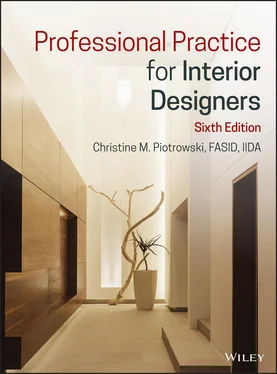Christine M. Piotrowski - Professional Practice for Interior Designers
Здесь есть возможность читать онлайн «Christine M. Piotrowski - Professional Practice for Interior Designers» — ознакомительный отрывок электронной книги совершенно бесплатно, а после прочтения отрывка купить полную версию. В некоторых случаях можно слушать аудио, скачать через торрент в формате fb2 и присутствует краткое содержание. Жанр: unrecognised, на английском языке. Описание произведения, (предисловие) а так же отзывы посетителей доступны на портале библиотеки ЛибКат.
- Название:Professional Practice for Interior Designers
- Автор:
- Жанр:
- Год:неизвестен
- ISBN:нет данных
- Рейтинг книги:4 / 5. Голосов: 1
-
Избранное:Добавить в избранное
- Отзывы:
-
Ваша оценка:
- 80
- 1
- 2
- 3
- 4
- 5
Professional Practice for Interior Designers: краткое содержание, описание и аннотация
Предлагаем к чтению аннотацию, описание, краткое содержание или предисловие (зависит от того, что написал сам автор книги «Professional Practice for Interior Designers»). Если вы не нашли необходимую информацию о книге — напишите в комментариях, мы постараемся отыскать её.
Professional Practice for Interior Designers
Professional Practice for Interior Designers — читать онлайн ознакомительный отрывок
Ниже представлен текст книги, разбитый по страницам. Система сохранения места последней прочитанной страницы, позволяет с удобством читать онлайн бесплатно книгу «Professional Practice for Interior Designers», без необходимости каждый раз заново искать на чём Вы остановились. Поставьте закладку, и сможете в любой момент перейти на страницу, на которой закончили чтение.
Интервал:
Закладка:
If you have an interest in a particular type of nonprofit organization, your public service will provide you with enriching opportunities to help your community and beyond. Not only are you helping out these nonprofits but you are also going to have the opportunity to meet many new people you might otherwise never meet. Just as you are encouraged to join and participate in a professional association, it is beneficial for you to participate in some sort of public service role.
You may have heard the term pro bono , which means providing something at no charge. Interior designers often provide their services at no charge to a community, church group, or nonprofit organization such as Habitat for Humanity. Pro bono work can be personally rewarding, in addition to helping these groups obtain top‐notch design services for little or no expense.
Another part of giving back comes in the form of working with students. As a student, you want to hear from working professionals. Not to challenge your professors, but to see how the academic meshes with the world of interior design. Lectures, guest critiques, tours of the designer's office facilities, and helping to arrange tours of significant design projects in the area are all examples of this important type of service.
The practice of interior design is a continually growing and changing profession. Our professional and social responsibility in this complex world will test both the individual entering the profession and the experienced professional. These challenges should be embraced, not shunned, as professional interior designers continue to lead the way in the design of exciting and satisfying interiors. Involvement in the interior design profession is in itself very rewarding. That satisfaction grows immensely.
HISTORICAL OVERVIEW
It is important for the reader to have an understanding of the history of the interior design profession as well as the history of furniture, architecture, and furnishings. This brief section provides some context for the history of the profession.
Before the 20th century, interior decoration was the responsibility of artisans, craftsmen, painters, sculptors, and early architects. Shopkeepers were called ensembliers or ateliers in Europe. According to John Pile, Charles Percier (1764–1838) and Pierre‐François‐Léonard Fontaine (1762–1853) are thought by many to be the first professional interior designers. “Percier and Fontaine conceived of interior spaces developed under their full control in the manner of modern interior designers.” 7
Elsie de Wolfe (1865–1950) was among the first individuals to bring the concept of professionalism to interior decoration in the United States. It was approximately during her career that the term interior decoration began to be used. Born in New York City and a member of the upper class, de Wolfe began her career as a professional interior decorator in 1904, when she was 39 years old. Her first commission, in 1905, was for the design of the Colony Club in New York City. Among de Wolfe's clients were such notable figures as Henry C. Frick and Anne Pierpont Morgan. Because these early decorators often had a wealthy clientele, the term society decorator was often associated with them.
De Wolfe also wrote one of the earliest books about interior decoration, The House in Good Taste , in which she related her philosophy of decoration for homes. This book, which was republished in 2004, gives a fascinating glimpse into early interior decoration. She also is credited with being responsible for another milestone in the profession: receiving a fee for her design services rather than a commission on the sale of furniture. 8De Wolfe's success inspired other women to enter the profession. It was one of the few acceptable professions for women at the turn of the century.
In approximately 1904, formal educational preparation was offered at the New York School of Applied and Fine Arts—founded as the Chase School. (This school is now known as Parsons, The New School for Design, located in New York City.) A few courses were offered in art or home economics programs in other schools, but formal training in interior decoration was not easy to obtain. Individuals who could not avail themselves of formal courses generally learned from magazines of the time, such as House Beautiful or House & Garden .
Postwar prosperity after World War I saw an increased interest in, and employment of, the interior decoration professional. In 1924, Eleanor McMillen opened McMillen Inc., claiming to be the first full‐service interior decorating firm in the United States. 9This postwar prosperity led to an increasing number of professionals with specialized knowledge in different types of interiors beyond residential interior decoration. By the late 1920s, many local “Decorators' Clubs” had been started in various parts of the country. The Decorators Club located in New York is credited with being one of the first, if not the first, such organization. 10
Furniture manufacturers in the 1920s were producing fine‐quality furniture in places such as Grand Rapids, Michigan, and High Point, North Carolina. Department stores used a display technique called a vignette to help the middle‐class consumer visualize a room of furniture and thus encouraged consumers to utilize better‐quality design in their homes. 11(Vignette, as used in the interior design profession, means a display of furniture and furnishings that simulates an actual room.) Magazines continued to be used by the masses of consumers to appreciate quality interior decoration done by professionals and primarily available only to the wealthy.
The Great Depression of the 1930s had a profound influence on the furniture industry and thus the interiors profession. It had a disastrous effect on the ability of the middle class to purchase furniture. Yet, the leading society decorators remained relatively unaffected by the depression, as their wealthy clients could still afford to purchase quality goods. The society decorators, however, were purchasing goods from Europe rather than using American‐made goods. This had a further, and decidedly negative, impact on American manufacturers.
Grand Rapids, Michigan, was the site of one of the earliest and largest to‐the‐trade‐only semiannual furniture markets. At the time, Grand Rapids was one of the largest manufacturing centers in the United States. The Grand Rapids Furniture Exposition, as it was officially called, was first held in December 1878. 12The market was held in January and June for 87 years. Local manufacturers displayed their products, educational programs were held, and manufacturers from other locations rented storefronts to show their goods.
The leaders of the Grand Rapids manufacturing center in the 1930s needed to bring the decorators to Grand Rapids so that they could see the quality of American‐made furniture. With William R. Moore of Chicago, they put together a conference to organize a national professional organization. The conference was held during July 1931, in Grand Rapids, and speakers such as Frank Lloyd Wright were scheduled to appear in order to entice decorators to the conference. The decorators were invited to the various manufacturing plants and showrooms to see the furniture firsthand. By the end of the conference, the American Institute of Interior Decorators (AIID)—the precursor to the American Society of Interior Designers (ASID)—had been founded, with William R. Moore as its first national president.
World War II led to new manufacturing techniques that changed furniture and design styles. The modernism of the Bauhaus school—originally located in Germany—greatly influenced the design of buildings and interiors in the United States. Consumers had larger disposable incomes and were willing to buy again. It was during the 1940s that the term decorator began to lose favor in the industry. It was also at this time that educational standards and the number of programs offered grew, as interest in the profession increased. Massive growth in industrialism after the war also boosted the building, furniture, and interiors industries.
Читать дальшеИнтервал:
Закладка:
Похожие книги на «Professional Practice for Interior Designers»
Представляем Вашему вниманию похожие книги на «Professional Practice for Interior Designers» списком для выбора. Мы отобрали схожую по названию и смыслу литературу в надежде предоставить читателям больше вариантов отыскать новые, интересные, ещё непрочитанные произведения.
Обсуждение, отзывы о книге «Professional Practice for Interior Designers» и просто собственные мнения читателей. Оставьте ваши комментарии, напишите, что Вы думаете о произведении, его смысле или главных героях. Укажите что конкретно понравилось, а что нет, и почему Вы так считаете.












